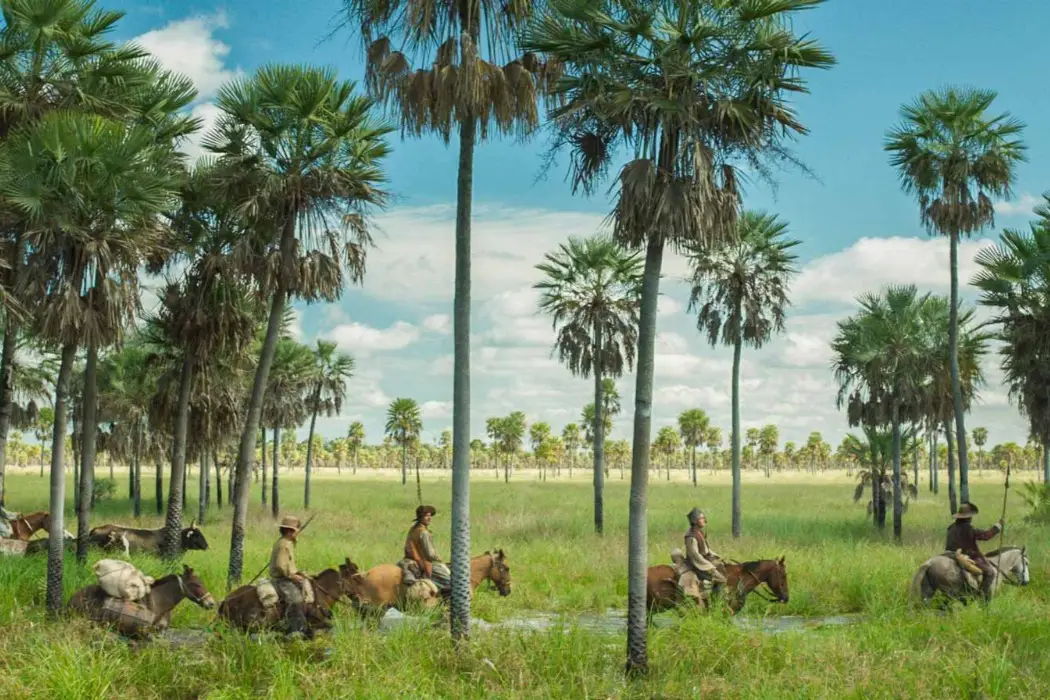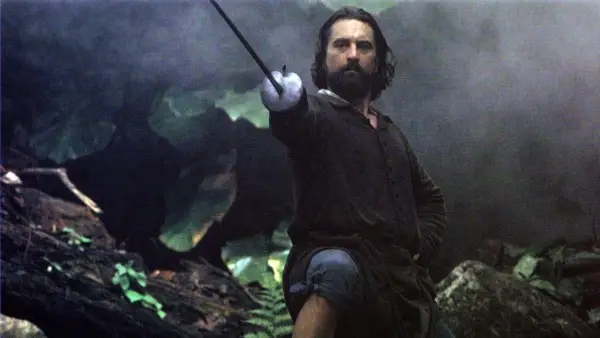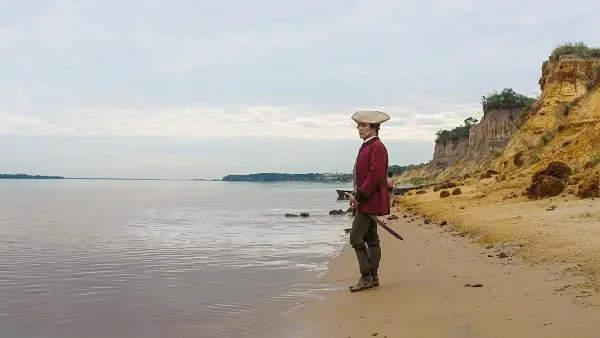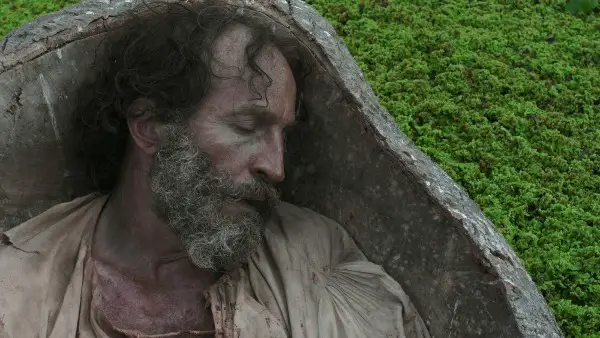Depictions Of Colonialism In THE MISSION & ZAMA

Andrew Emerson is a University of Chicago student. His high…
Two award-winning films illustrate how cinema can either reinforce or dismantle traditional understandings of colonialism and the Age of Exploration. The first one, Roland Joffé’s The Mission (1986), follows the story of Father Gabriel (Jeremy Irons), a Jesuit priest who establishes a mission in an indigenous Guaraní community near Iguazu Falls. The second film, Lucrecia Martel’s Zama (2017), constitutes a character study of Don Diego de Zama (Daniel Giménez Cacho), a Spanish magistrate who works in a remote Paraguayan village.
Part I: The Mission
To start, The Mission could easily come off as an anti-colonialist film. The main narrative, after all, revolves around a conflict between Father Gabriel and two Europeans named Don Cabeza (Chuck Low) and Don Hontar (Ronald Pickup). While Gabriel believes that the Guaraní are intelligent and worthy of respect, Cabeza and Hontar are portrayed as unabashed racists who view natives as nothing more than a source of cheap labor. Sadly, the latter’s worldview ultimately triumphs after European soldiers destroy Gabriel’s mission and massacre all its inhabitants. As one critic put it, it’s a tragic conclusion that aims to “make you hate the whole of Western civilization with every fiber of your being.”
And yet: even as it recounts this ostensibly anti-colonialist narrative, the sad irony of The Mission is that it still ends up romanticizing the colonial era. More specifically, Joffé’s use of film form promotes two myths about European exploration. First, he exoticizes the Americas, portraying them as a “terra incognita” wilderness that brims with “adventure.” Second, despite its condemnation of Cabeza and Hontar, the film ultimately provides an apologia for Europeans, depicting natives as unenlightened individuals who benefited from white people’s “civilization.”
To begin with, an early scene in the film offers a good illustration of how Joffé exoticizes the Americas. In said scene, Father Gabriel is making his first foray into Guaraní territory; to reach the center of their community, he has to climb up a cliff that’s located right next to a group of waterfalls. As he ascends the cliff, he initially slips – and for a moment, it looks like he might fall to his death. Fortunately, however, he eventually regains his footing and manages to reach the top.

As described here, this scene might seem innocuous, a nondescript depiction of a transitional moment in the narrative. But consider the way the scene is styled. When Gabriel regains his footing, soaring orchestral music begins to play in the background, and it keeps crescendoing until he reaches the top of the cliff. After Gabriel completes his climb, the camera zooms outward from a close-up of his face to a long shot, thereby offering us a sweeping view of the waterfalls abutting the cliff.
Both of these formal elements engender a romanticized depiction of the South American wilderness. On the one hand, the triumphant orchestral music melodramatizes Gabriel’s ascent, making a simple “work commute” appear like an epic struggle between man and nature. Moreover, by setting Gabriel against the backdrop of a towering waterfall, the camera’s outward zoom portrays him as an intrepid explorer, as though he were a daring individual who had boldly penetrated a vast parcel of untouched, virgin wilderness. In less than a minute, in short, this scene promotes an exoticized view of the Americas, depicting them as a quasi-mystical “land of adventure” where the courageous can test their mettle against “the elements.”
From here, the other big problem with The Mission manifests itself in the sequence that depicts the destruction of Gabriel’s mission. Narratively speaking, this sequence begins when a troop of European soldiers breach the mission’s defenses and start shooting down its inhabitants. In addition to witnessing the death of Rodrigo (Robert de Niro), a colleague of Gabriel’s, we watch Gabriel die as he leads a procession of natives from the mission’s church. As Gabriel, Rodrigo, and the natives are killed, moreover, the mission itself is also gradually demolished by a fire.
On the whole, the “message” of this sequence is shaped by three elements of its form. First, aside from the occasional shot of gun-brandishing soldiers, the first part of the sequence generally alternates between close-up shots of a dying Rodrigo and shots of Gabriel’s procession: in the latter, if he’s not already in close-up, Gabriel is usually positioned near the center of the frame. Second, after the massacre is over, Joffé dissolves to a series of panning shots that depict the flames consuming the now-empty mission. And third, this sequence is also set to a wistful, melancholic rendition of “Gabriel’s Oboe,” one of the main themes from the film’s soundtrack.
Taken together, these three elements imbue the sequence with a pro-European slant. For one, the alternating shots in the first part foreground Gabriel and Rodrigo’s pain. Rather than highlight the deaths of the mission’s native inhabitants, in other words, the sequence focuses on those of the white characters instead, as though to suggest that Gabriel and Rodrigo’s deaths were singularly lamentable injustices. When seen alongside the rendition of “Gabriel’s Oboe,” moreover, the panning shots of the burning mission play like a lament, as though Joffé were bemoaning the untimely destruction of a wonderful, beneficial, and tragically misunderstood enterprise.
All told, in short, this destruction sequence implies that the Europeans were a net plus for native communities. Yes, some Europeans (Don Cabeza, Don Hontar) were jerks. But in Joffé’s telling, there were also “good Europeans” like Gabriel, and benighted indigenous communities ultimately benefited from the “civilization” and religion that these Europeans proffered. Like Rudyard Kipling’s “The White Man’s Burden,” The Mission thus serves as an exemplar of condescending benevolence – a worldview, namely, where indigenous communities are not flat-out “savages,” but rather pitiable primitives who can be educated with the help of knowing whites.
Part II – Zama
While The Mission reinforces dangerous myths about the colonial era, Zama dismantles them right from the get-go. The film opens with a shot in which Zama walks along the edge of a large body of water; in the background, moreover, a group of natives can be seen unloading cargo from a boat. This shot is a long take that lasts a whole minute, and throughout it, the camera remains completely still.

Leaving aside the fact that it’s a long take, there are three things about this shot that are worth noting. First, most of the frame is “taken up” by the aforementioned body of water and the sky above Zama, a composition that makes him look literally insignificant. Second, Zama is wearing a fancy outfit – a three-cornered hat, a tailored suit, a sword at his side – that looks very out of place in his rural surroundings. And lastly, the landscape is relatively empty: if you removed Zama and the natives from the shot, all you’d have left is a flat, largely unremarkable view of a beach on a cloudy day.
If The Mission exoticizes the Americas, this opening moment in Zama does the exact opposite. Far from portraying the Americas as a “land of adventure,” the shot’s duration and nondescriptness make them out to be an uninteresting source of tedium. And instead of depicting him as an intrepid adventurer who triumphs over “the elements,” the shot’s framing and costuming portray Zama as helpless, casting him as an impotent weakling who’s unable to adapt to non-European environments. With this one long take, then, Martel “demythifies” the Age of Exploration, upturning the romanticized depiction of the Americas that Joffé espouses in his work.
Meanwhile, another subversive moment in Zama occurs a little over an hour into the film. In this scene, a weary Zama is shown talking with a scribe named Fernández (Nahuel Cano). Their exchange takes place in a dark room that contains a window in the back wall; importantly, this window also allows us to see that a group of natives are standing outside. Throughout Zama and Fernandez’s subdued conversation, these natives are always present in the background, but neither of the two men acknowledges their presence.
Understanding this “conversation scene” requires some context. Earlier in the film, Zama’s boss, a pompous man who’s always referred to as “the Governor” (Daniel Veronese), upbraided Fernández for using work time to write a book rather than transcribe royal documents. Given the monotonous nature of said transcription work, Fernández’s behavior is perfectly understandable. But in a move that smacks of a “power for power’s sake” mentality, the Governor still insists that Zama write up a “ruthless” and “damning” report on Fernández’s transgression. In the conversation scene itself, Zama explains the Governor’s attitude to Fernández, noting that “The Governor feels that working hours at the Government House are to serve the King.”
When viewed with this background in mind, the conversation scene acquires two layers of meaning. On the one hand, thanks to the Governor’s upbraiding, both Zama and Fernández realize that the Spanish colonial system is an empty, bureaucratic mess. Neither of them is willing to admit this openly. But as evidenced by their tired, quietly frustrated demeanors, they’ve both come to see that the enterprise to which they’ve devoted their entire careers is heavily, hopelessly flawed.
The true import of this scene, however, becomes apparent when you consider its mise-en-scène. Zama and his subordinate now recognize that the colonial system is flawed. But as suggested by the constant, unacknowledged presence of the natives in the background, they remain hopelessly blind to the colonial system’s biggest flaw: the way it exploited and mistreated indigenous communities. To put it differently, even as Zama and his subordinate become cognizant of colonialism’s badness, they only see this badness in terms of the effects it has on themselves, overlooking the even worse effects it has on natives.

This depiction of Zama’s obliviousness takes on special significance when you place it in historical context. Throughout the colonial and imperialist eras, European endeavors in the Third World attracted plenty of criticism. But instead of attacking the way European governments abused natives, many of these critiques focused on the damage that colonialism and imperialism supposedly inflicted on Europeans.
Here are just two examples of what I mean by this. Bartolomé de las Casas’ A Short Account of the Destruction of the Indies condemned the way the Spanish mistreated natives in the West Indies, a stance that famously earned Howard Zinn’s praise in A People’s History of the United States. Far from empathizing with these natives, however, Bartolomé justified his criticism on narrow grounds, claiming that such mistreatment violated the “civilizing” mission that was “entrusted by God and the Church to the Spanish Crown.”[1]
Flash forward a few centuries, and you’ll find another illustration of this Eurocentric mentality in Joseph Conrad’s Heart of Darkness. As emblemized by Kurtz’s famous last words (“The horror! The horror!”), Conrad believed that British imperialism was debasing and dehumanizing. But he didn’t make these assertions out of concern for ordinary Africans. Rather, as Chinua Achebe famously argued in “An Image of Africa,” Heart of Darkness indicates that imperialism primarily hurt Europeans – mainly because it rendered them as “savage” and “primitive” as the Africans they ruled over.
In short, with this conversation scene, Martel is really delivering a rebuke to a long-standing tradition in anti-colonialist and anti-imperialist literature. She illustrates how Europeans consistently prioritized their well-being over everyone else’s, to the point that even the most liberal among them couldn’t see non-Europeans as human beings. Whereas The Mission portrays whites as benevolent and all-knowing, then, Zama’s message is that Europeans were actually short-sighted, narcissistic, and utterly lacking in self-awareness. In that sense, Martel’s film stands as an indirect but meaningful effort to restore dignity to much-abused native communities.
Do you agree with me? Why or why not? Please share your thoughts in the comments!
[1]: For more on this, see Bartolomé de las Casas, A Short Account of the Destruction of the Indies, ed. and trans. Nigel Griffin (London: Penguin Books, 1992). The quote comes from page 6.
Does content like this matter to you?
Become a Member and support film journalism. Unlock access to all of Film Inquiry`s great articles. Join a community of like-minded readers who are passionate about cinema - get access to our private members Network, give back to independent filmmakers, and more.
Andrew Emerson is a University of Chicago student. His high school English teacher once asked him to read a batch of Roger Ebert’s reviews for class, and he’s been fixated on the idea of writing about movies ever since. You can follow his attempts to pursue this obsession at http://filmwatcher.net/.













